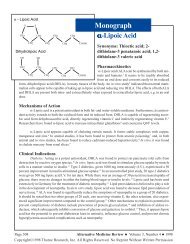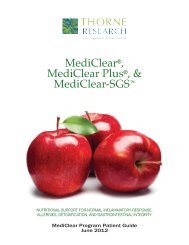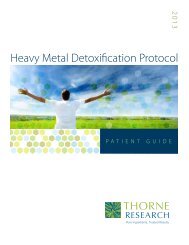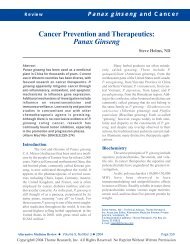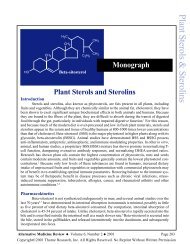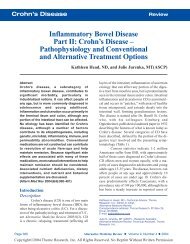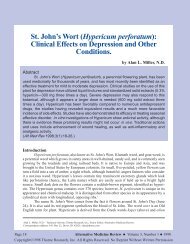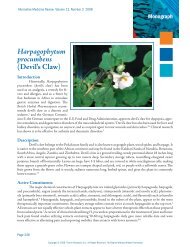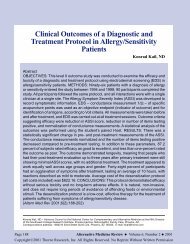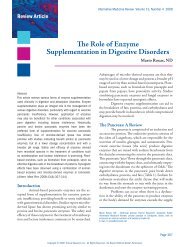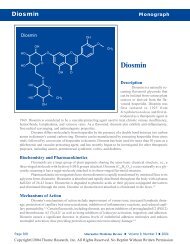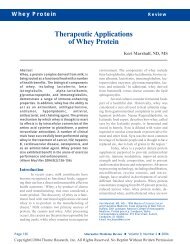Sulforaphane/Sulforaphane glucosinolate - Thorne Research
Sulforaphane/Sulforaphane glucosinolate - Thorne Research
Sulforaphane/Sulforaphane glucosinolate - Thorne Research
You also want an ePaper? Increase the reach of your titles
YUMPU automatically turns print PDFs into web optimized ePapers that Google loves.
Animal <strong>Research</strong>: <strong>Sulforaphane</strong>/<strong>Sulforaphane</strong> <strong>glucosinolate</strong><br />
Inhibition of synovial hyperplasia, rheumatoid T cell activation, and experimental arthritis in mice by<br />
sulforaphane, a naturally occurring isothiocyanate.<br />
Kong JS, Yoo SA, Kim HS, et al. Arthritis Rheum 2010;62:159-170.<br />
Rheumatoid arthritis involves a tumor-like expansion of the synovium characterized by<br />
hyperproliferation of synoviocytes, infiltration of T and B cells and increases in interleukins-6, -8, and -<br />
17. The in vivo effects of sulforaphane on synoviocyte hyperplasia and T cell activation were examined in<br />
mice with experimentally induced rheumatoid arthritis. <strong>Sulforaphane</strong> induced synoviocyte apoptosis,<br />
inhibited T cell proliferation, and production of interleukin-17 (IL-17) and tumor necrosis factor alpha<br />
(TNFalpha). Intraperitoneal administration of sulforaphane to mice also suppressed the clinical severity<br />
of arthritis. The antiarthritic and immune regulatory effects of sulforaphane suggest it may offer a<br />
possible treatment option for RA.<br />
<strong>Sulforaphane</strong> inhibits prostate carcinogenesis and pulmonary metastasis in TRAMP mice in association<br />
with increased cytotoxicity of natural killer cells.<br />
Singh SV, Warin R, Xiao D, et al. Cancer Res 2009;69:2117-2125.<br />
An animal model of prostate cancer shows that oral gavage of sulforaphane thrice per week beginning<br />
at six weeks of age, significantly inhibits prostate carcinogenesis and pulmonary metastasis in mice,<br />
without causing any side effects. The incidence of prostatic intraepithelial neoplasia and welldifferentiated<br />
carcinoma were approximately 23-28-percent lower in the dorsolateral prostate of<br />
sulforaphane-treated mice when compared with controls. Strikingly, the sulforaphane-treated mice<br />
exhibited approximately 50% and 63% decrease, respectively, in pulmonary metastasis incidence and<br />
multiplicity compared with control mice. The dorsolateral prostate from treated mice showed decreased<br />
cellular proliferation and increased apoptosis when compared with that from control mice. These results<br />
indicate that sulforaphane administration inhibits prostate cancer progression and pulmonary<br />
metastasis in mice by reducing cell proliferation and augmenting NK cell lytic activity.<br />
<strong>Sulforaphane</strong>, a dietary component of broccoli/broccoli sprouts, inhibits breast cancer stem cells.<br />
Li Y, Zhang T, Korkaya H, et al. Clin Cancer Res 2010;16:2580-2590.<br />
A nonobese diabetic/severe combined immunodeficient xenograft mouse model was used to determine<br />
whether sulforaphane could target breast cancer stem cells in vivo, as assessed by Aldefluor assay, and<br />
tumor growth upon cell reimplantation in secondary mice. <strong>Sulforaphane</strong> (1-5 micromol/L) decreased the<br />
aldehyde dehydrogenase-positive cell population by 65% to 80% in human breast cancer cells and<br />
reduced the size and number of primary mammospheres by 8- to 125-fold and 45% to 75%, respectively.<br />
Daily injection with 50 mg/kg sulforaphane for 2 weeks reduced aldehyde dehydrogenase-positive cells<br />
by >50% in nonobese diabetic/severe combined immunodeficient xenograft tumors and eliminated<br />
breast cancer stem cells in vivo, thereby abrogating tumor growth after the reimplantation of primary<br />
tumor cells into the secondary mice. These findings support the use of sulforaphane for the<br />
chemoprevention of breast cancer and warrant further clinical evaluation.<br />
<strong>Sulforaphane</strong> induces thioredoxin through the antioxidant-responsive element and attenuates retinal<br />
light damage in mice.<br />
Tanito M, Masutani H, Kim YC, et al. Invest Ophthalmol Vis Sci 2005;46:979-987.



